When selecting outdoor bonsai tree containers, size matters—opt for pots about two-thirds the height of your tree, and keep drainage in mind, so your roots don’t drown! Materials like mica can keep roots cozy, while ceramics breathe better than plastic. Want aesthetics? Match your pot shape with your tree’s vibe—masculine trees love deep rectangles, while graceful feminine trees shine in round pots. Curious about colors and depth? Stick around, and we’ll explore those elements too!
Quick Takeaways
- Choose a pot size that is two-thirds the height of the tree, considering its age and root status to prevent health issues.
- Select pot material based on durability and air circulation; options include mica, unglazed ceramic, and avoid metal for toxin concerns.
- Ensure multiple drainage holes are present to prevent waterlogging, and include a drainage layer for optimal soil aeration.
- Match pot shape with tree style; deep, rectangular pots suit masculine trees, while round or oval pots enhance feminine trees’ elegance.
- Select colors that complement the tree’s character; earthy tones provide harmony while contrasting colors can highlight vibrant foliage.
Assessing the Appropriate Size for Your Bonsai Pot
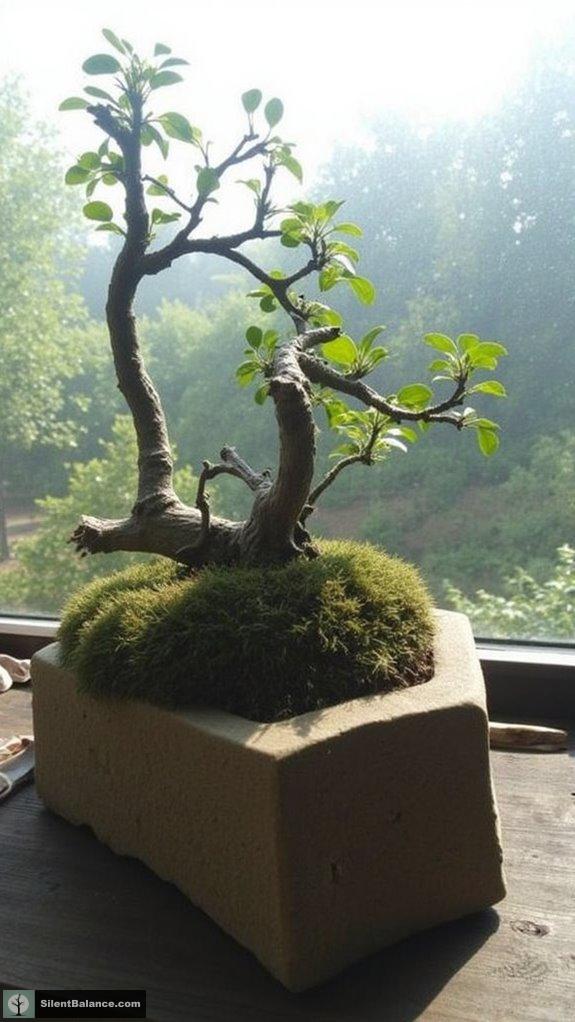
When it comes to choosing the right pot for your bonsai, have you ever wondered how size truly impacts your tree’s health and aesthetics?
Let me tell you, a pot that’s too small? That’s like a tight pair of shoes—nobody wins!
For upright styles, aim for a pot about two-thirds the height of your tree, while wider trees need a pot that matches their canopy spread. Remember, pot size decision depends on factors like tree age and root bound status.
Don’t forget width. It should be slightly narrower than the longest branch to keep things balanced.
And here’s a fun fact: if you’ve got a rugged tree, opt for a hard, angular pot—it just screams strength!
Trust me, once you nail the size, your bonsai bliss will shine brighter than ever!
Choosing the Right Material for Outdoor Conditions
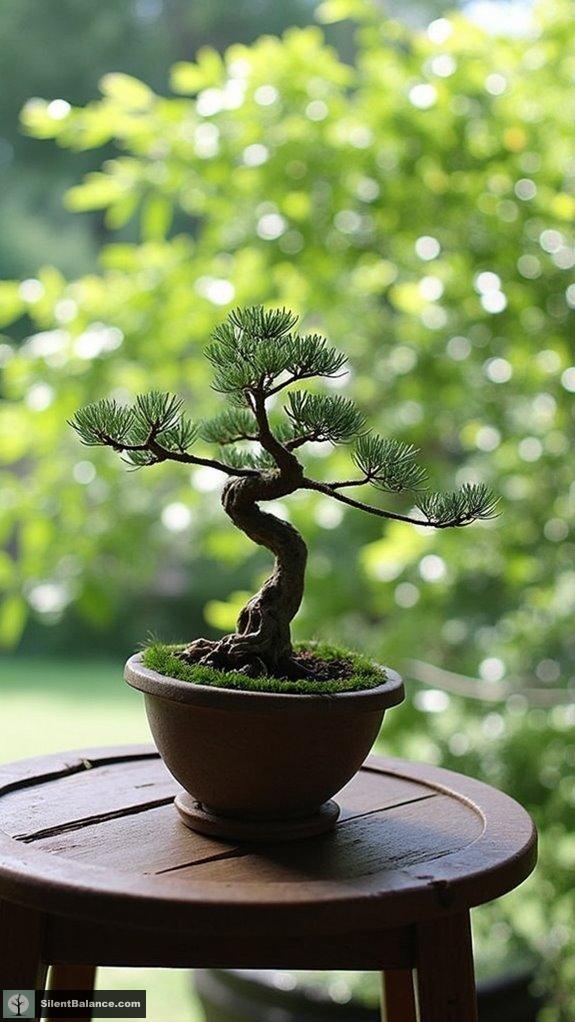
Choosing the right material for your outdoor bonsai containers isn’t just a matter of preference; it’s essential for your tree’s health and longevity. Ancient bonsai are imbued with spiritual symbolism that reflects the deep connection between nature and artistry.
Here’s a quick overview of materials you might consider:
| Material | Durability/Weather Resistance | Porosity/Root Benefits |
|---|---|---|
| Mica | High durability, resists cracking | Stable root temperatures |
| Plastic Resin | Inexpensive, easily modified | Non-porous, need drainage |
| Unglazed Ceramic | Brittle, better air circulation | Excellent moisture balance |
| Glazed Ceramic | Less impact-resistant | Limited oxygen availability |
| Metal | Risk of toxin release | N/A |
I often lean toward mica or unglazed ceramic for cozy, outdoor vibes. Selecting the right pot is critical for achieving traditional bonsai art style to ensure your tree thrives in its environment. What about you? Always keep in mind, the right pot can make all the difference in your bonsai’s journey.
Ensuring Proper Drainage and Stability
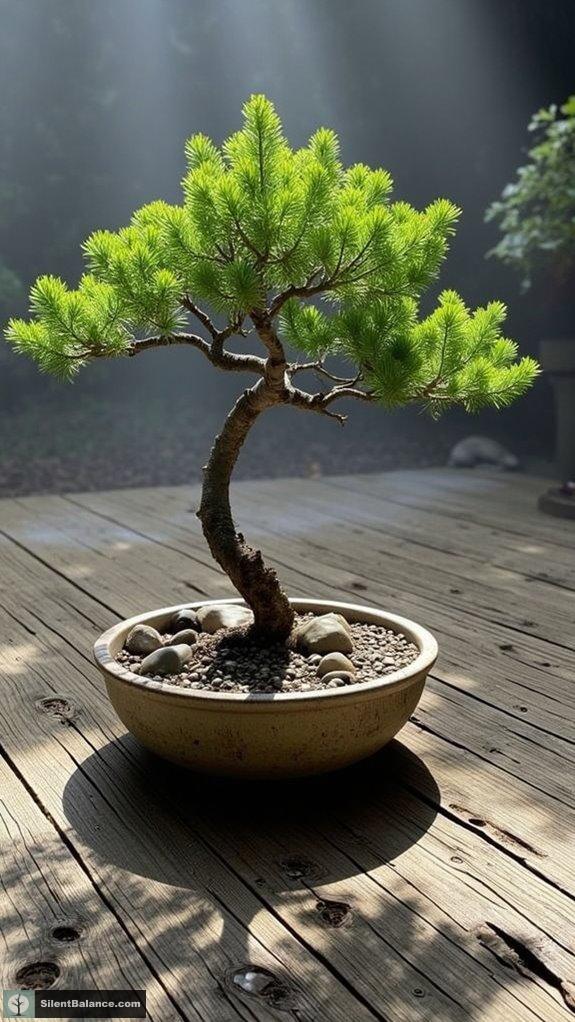
To keep your outdoor bonsai thriving, you’ve got to guarantee both proper drainage and stability in its container.
Think about it: waterlogged soil invites root rot, and that’s a big no-no. I make sure my pots have multiple drainage holes; even a couple of drilled holes can help.
Now, let’s talk stability. Secure your bonsai with tie-down wires threaded through those drainage holes, creating a tight embrace for the rootball. The last thing you want is your little tree swaying in the wind like a dancer at a party!
And don’t forget to add a drainage layer—think coarse grit or small rocks. This keeps things airy and happy for your roots. Additionally, choosing the right container material can influence your bonsai’s growth and wellbeing as it contributes to the plant’s overall health and energy.
Who knew container care could be this much fun?
Matching Pot Shape With Tree Style

Selecting the right pot shape for your bonsai isn’t just a matter of aesthetics; it’s about harmony between the tree and its container, creating a delightful balance in your outdoor oasis.
Have you noticed how masculine trees, with their strong, tapering trunks, thrive in deep, rectangular pots? They radiate strength like a weightlifter in the gym!
Meanwhile, those graceful, feminine trees love round or oval pots, delicately perched on their little feet. It’s like choosing the perfect outfit for a date!
Now, if you have a cascade or semi-cascade bonsai, go for tall pots; they’re the glamazons of the bonsai world, ready to showcase their stunning downward growth.
Trust me, matching pot shapes to tree styles transforms your garden into a serene masterpiece!
Selecting Colors That Enhance Your Bonsai’S Character
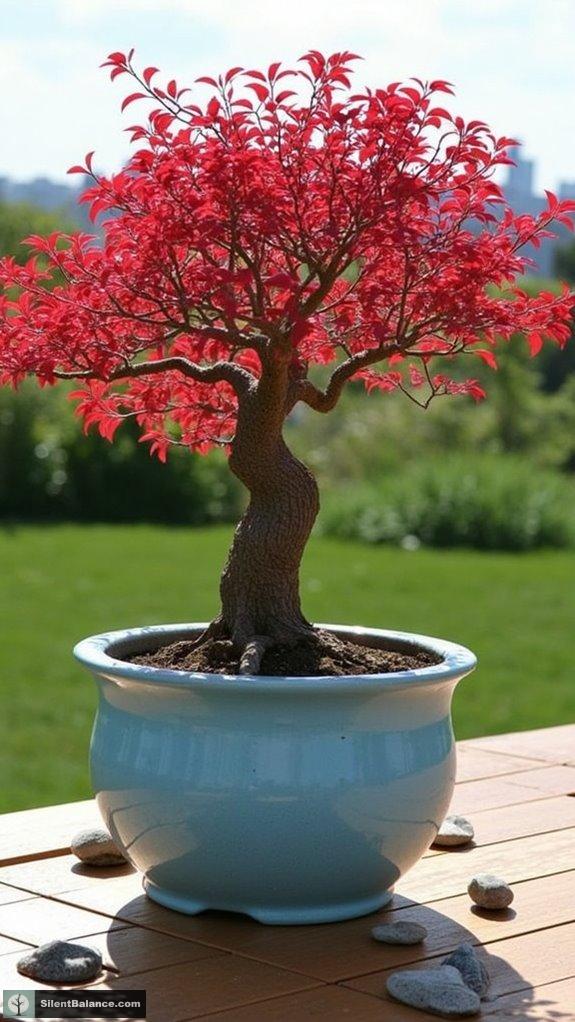
Have you ever wandered through a garden and marveled at how certain colors catch your eye, making the plants seem to pop?
When picking a pot for your bonsai, think about how color can amplify its character without stealing the show.
For instance, if your tree flaunts fiery red leaves, a light blue pot can create a dazzling contrast. Isn’t that gorgeous?
Earthy tones like browns and grays let the tree’s features shine, creating a harmonious vibe.
You might want to experiment with unglazed pots, too—such subtlety exudes a natural elegance that just feels right.
Trust me, the right pot color can transform your bonsai into a true masterpiece that demands a second look!
Understanding Pot Depth and Its Impact on Growth
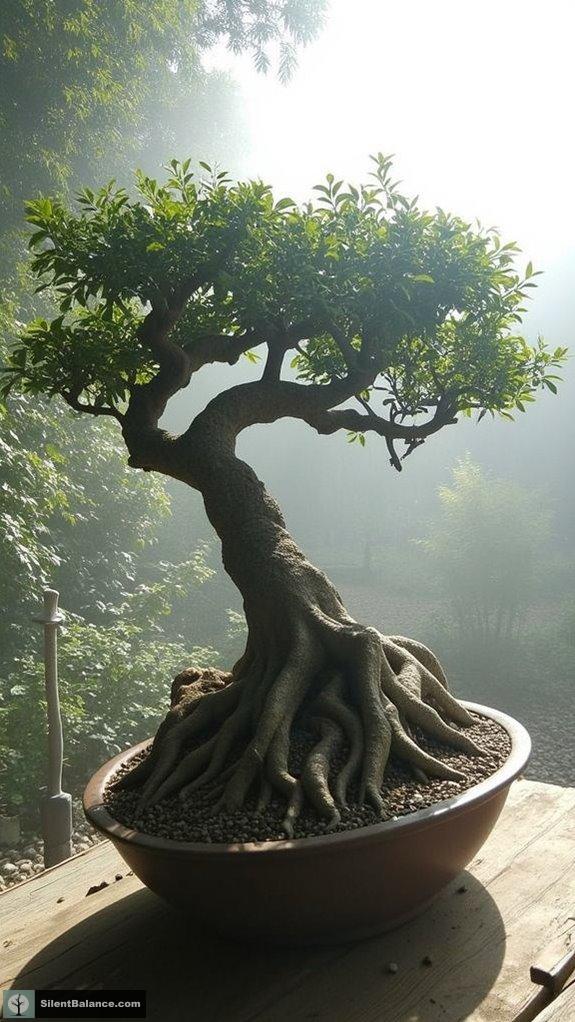
When you’re diving into the world of bonsai, pot depth is more than just a matter of preference—it’s an essential part of your tree’s health and happiness.
You see, the ideal pot depth should align with your tree’s trunk diameter just above the soil level.
But I often find myself in the occasional debate about making exceptions for robust trunks or species like the Japanese White Pine, which thrive in deeper pots.
Deeper pots do wonders for drainage and aeration, keeping those roots happy and healthy.
You wouldn’t want your precious bonsai to feel cramped, right? If it’s standing tall but top-heavy, a deeper pot might just provide the stability it desperately needs.
Transitioning From Nursery Pots to Aesthetic Containers
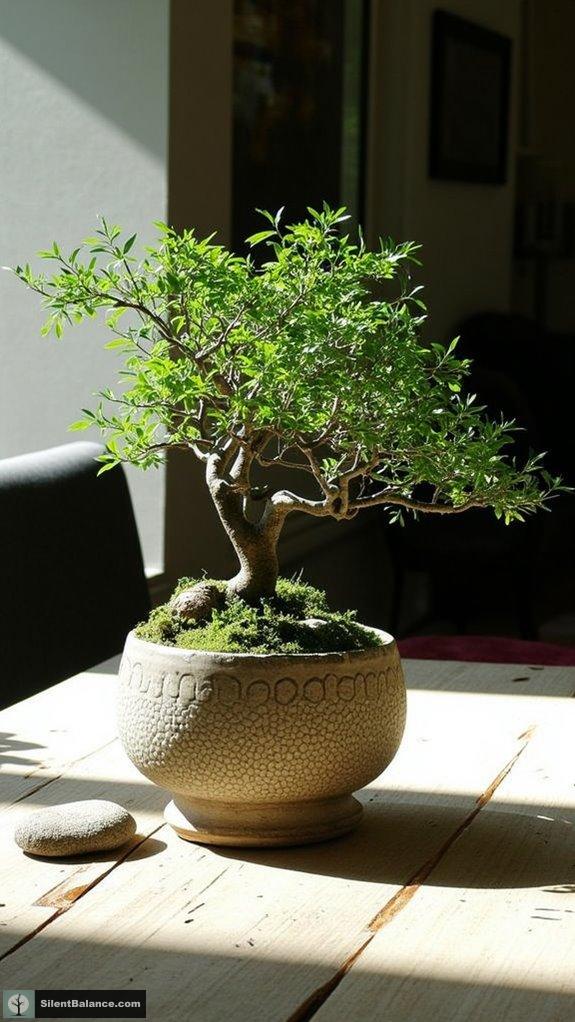
After reflecting on the depth of your bonsai pots, it’s time to chat about moving from those straightforward nursery pots to something more aesthetically pleasing.
When the trunk and branches have had some time to develop, you’ll want to take into account a shift.
But hey, don’t rush it! Depending on your bonsai’s growth rate, you might wait a year or more.
Think about selecting slightly larger, affordable containers initially—trust me, you’ll thank yourself later.
Make sure those pots have drainage holes; we don’t want any root rot ruining our little zen buddies.
And don’t shy away from ceramic or stoneware for elegance—it’s like dressing your bonsai for success!
Bonsai Tree Symbolism
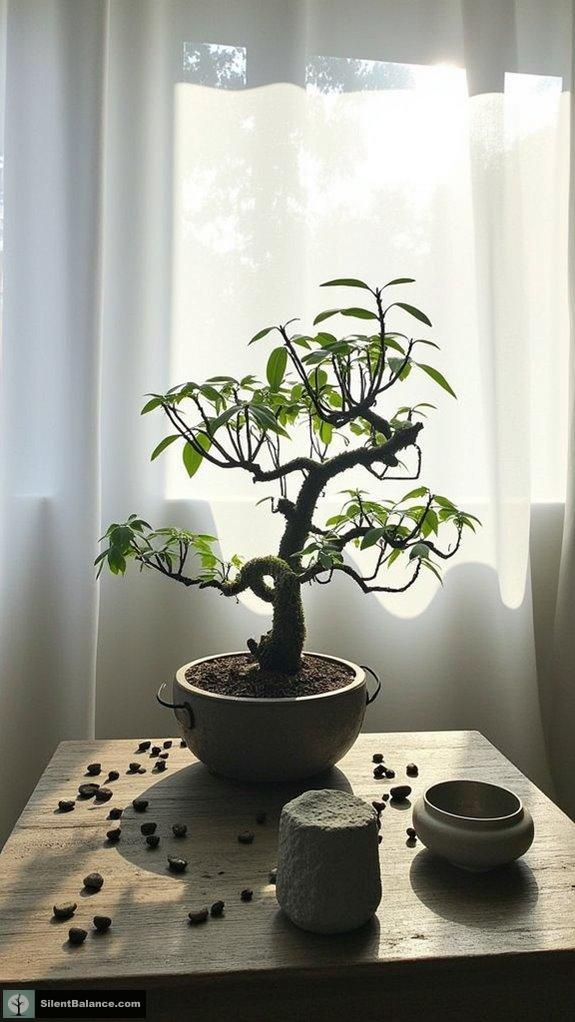
Bonsai trees aren’t just tiny versions of their towering counterparts; they’re vibrant symbols steeped in rich cultural history and philosophical significance.
They originated as “penjing” in China, representing the artistry and prestige of royalty, then wove themselves into Japanese culture, promoting balance and simplicity.
Who doesn’t love the idea of having a Zen-like serenity in their home, right?
Each bonsai reflects intentional choices—like a life sculpted with care and patience. The years we spend nurturing these living sculptures remind us of growth and mindfulness.
Selecting a bonsai tree isn’t just about aesthetics; it’s about picking a spiritual companion to encourage harmony in our lives.
Tree Symbolism
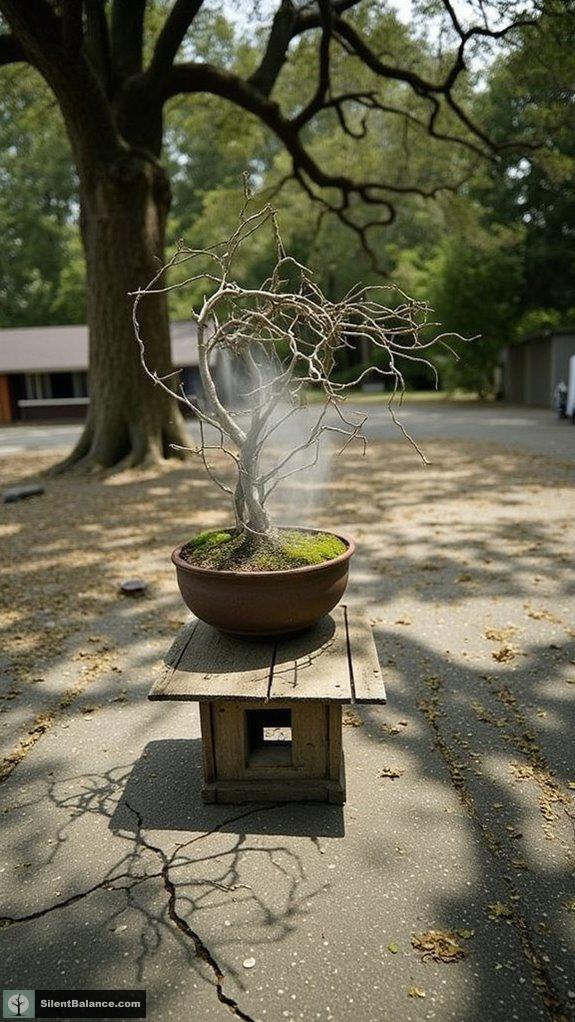
Tree symbolism runs deep across cultures and ages, weaving tales of connection and meaning that can leave anyone enchanted.
Take the Tree of Life, for instance. It’s this amazing symbol of harmony, bridging earth and sky, embodying resilience and growth.
In cultures like the Celts, trees serve as sacred beings, connecting ancestors to the present. Can you feel that special energy?
Then there’s Yggdrasil, the Norse World Tree. It reminds us of cosmic interconnectedness.
I mean, who doesn’t want to feel that sense of belonging?
Questions and Answers
How Often Should I Repot My Outdoor Bonsai Tree?
I usually repot my outdoor bonsai every two to three years. For younger, fast-growing trees, I do it every one to two years, while older ones can extend up to six or even ten years.
Can I Use Regular Plant Pots for Bonsai?
Oh, sure! Just grab any random pot from your pantry and call it a bonsai home! But really, I’d stick to pots with proper drainage and the right aesthetics for my little tree’s happiness.
What Is the Best Pot for Beginner Bonsai Enthusiasts?
When choosing a pot as a beginner, I recommend lightweight plastic or simple ceramic options. They’re affordable, easy to handle, and don’t distract from your bonsai tree’s beauty as you develop your skills.
Should Outdoor Pots Be Insulated in Winter?
I believe outdoor pots should definitely be insulated in winter. It keeps the soil temperature stable and protects the roots from frost. Trust me, it makes a big difference in your bonsai’s survival!
How Do I Visually Complement My Garden Design With Bonsai Pots?
When I placed a deep green bonsai pot beside vibrant flowers, it perfectly highlighted the tree’s elegance. I always choose colors and shapes that echo my garden’s vibe, creating a serene, harmonious space that feels just right.
References
- https://www.bonsai-shop.com/en/bonsaipots/selection
- https://www.bonsaiable.com/blog/pots-for-bonsai-trees
- https://bonsaitonight.com/2021/02/27/aligning-containers-with-development-goals/
- https://www.bonsaiempire.com/basics/bonsai-care/choosing-pots
- https://www.youtube.com/watch?v=xWHwez_n2G0
- https://www.bonsaioutlet.com/what-size-pot-to-use-for-your-bonsai-tree/
- https://www.youtube.com/watch?v=3T1gkvDiGCQ
- https://cincinnatibonsai.org/bonsai-tree-size-guide
- https://bonsaishop.com.au/2024/10/09/choosing-pot-for-your-bonsai-tree/
- https://forum.bonsaimirai.com/t/possible-bonsai-pot-alternatives/4442
- https://www.bonsainut.com/threads/nursery-pots-vs-grow-bags.39660/
- https://bonsaitonight.com/2016/12/27/secure-bonsai-pot/
- https://forum.bonsaimirai.com/t/should-outdoor-bonsais-have-a-drip-tray/8102
- https://miyagibonsai.co.uk/blog/bonsai-care/do-bonsai-pots-need-drainage-holes/
- https://www.bonsainut.com/threads/drainage-layers.3369/
- https://hookedonbonsai.com/how-do-i-choose-a-bonsai-pot/
- https://cincinnatibonsai.org/bonsai-tree-style-guide
- https://www.bonsaiempire.com/origin/bonsai-styles
- https://swindon-bonsai.co.uk/2015/01/19/bonsai-pot-colour-guide/
- https://forum.bonsaimirai.com/t/color-wheel-tool-for-pot-selection/7093
- Unique Bonsai Pots for Zen Home Decor - September 6, 2025
- 7 Essential Tips for Selecting Outdoor Bonsai Tree Containers - September 6, 2025
- Perfect Pots for Thriving Tropical Bonsai Tree Containers - September 5, 2025

